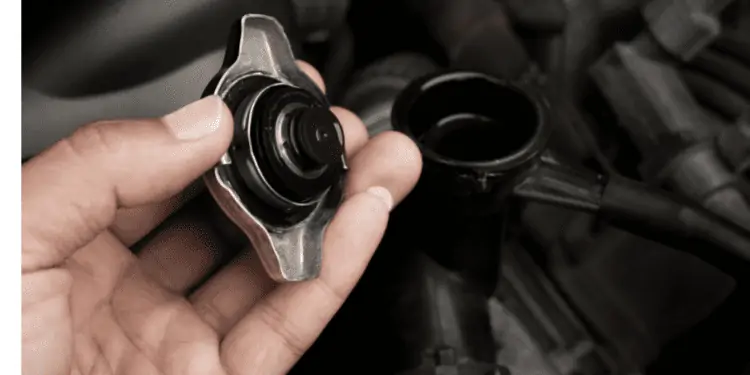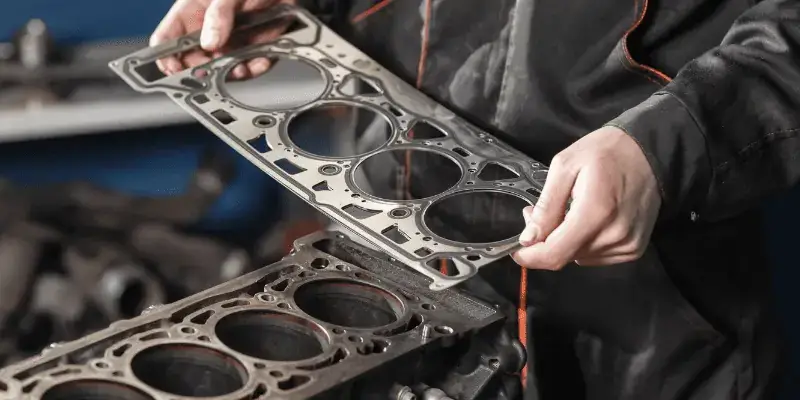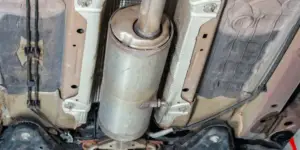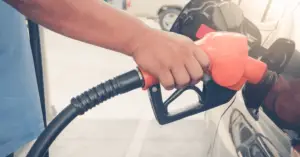There are three factors that contribute to coolant system pressure. We’ll explore them in this article. Luckily two are normal when the engine and radiator are cooling down but the third when the car is cold indicates a problem – often serious.
It’s really important to check if the car is completely cold. Any remaining engine warmth will result in pressure. We’ll explore a check you can do further on.
The three causes are
When the fluid expands, the air in the expansion tank is compressed. This is normal as the pressure will fall when the engine has cooled.
Secondly, coolant/water vapor pressure increases as a result of a rise in the coolant temperature. Again this is normal too if it depressurizes when it cools.
Third and finally, This leaves us with a serious problem of gases from the exhaust inside the coolant system.
To reiterate,
The first two causes rectify themselves as the engine cools down completely.
As for the third, pressure will remain high even when the last of the heat has left the engine.
There are two parts that fail and cause pressure to still be in the coolant system when cold.
They are
- A defective radiator cap
- A blown head gasket.
Before even checking those parts do this temperature check below:
Is Your Car Really Cold?
A car can take up to 12 hours to get completely cold after being turned off.
With the engine off, the water pump is off and can’t circulate the hotter engine coolant away from the engine. There is no air running past the radiator when the car is parked either which means the heat is being retained for longer.
Any heat within the coolant system will cause pressure. That’s why your car needs to be completely cold before being too concerned about potential faults.
Twelve hours is at the top end of the time taken to cool down. Normally six should be enough.
Do this check
Releasing any pressure within the system when your car is cold and hasn’t been driven for at least six hours. Wait 6 hours and open the radiator cap/reservoir cap again. Has it been repressurized?
If it hasn’t, this is good news and indicates that the radiator cap is sticking.
If pressure is back in the system, then it points to a head gasket fault. Exhaust gases could be leaking into the system when the engine is still cool.
Let’s look at these two causes in more detail.
Radiator Cap Faulty
It’s easy to check whether the radiator cap is not letting pressure out
Inspect the radiator cap. When the car is cold, take the cap off. You’ll see two rubber seals. One holds the radiator cap snugly in place against the radiator body. The other houses the valve that opens and shuts depending on the pressure it identifies in the system.
They can become stuck in the open or closed positions. In the closed position, they won’t allow pressure to escape. If it is stuck, the cap won’t allow air into the coolant system, and a vacuum is formed – exhibited as the system is under pressure.

If you have any doubts about the radiator cap. Replace it.
Make sure it is the right one for your car. Most caps have a range of operation between 6 and 16 psi. However, newer cars have higher pressure systems up to 20 psi.
If you’ve replaced it and it hasn’t fixed the problem, then it looks like the head gasket is blown.
The cost of a replacement radiator cap is between $15 and $25. It can be tempting to go for a cheap aftermarket one, but that can prove a false economy and cause you added stress if that fails too.
Sometimes, a pressure build-up can be caused by the coolant not circulating.
If you have old coolant your coolant system may become pressurized more quickly as the fluid will lose its heat absorbing properties and reach its boiling point quickly.
Many visitors read this article next: Is It Bad To Use Water Instead of Coolant? [ANSWERED]
Blown Head Gasket
Coolant and oil are kept from mixing with each other by the head gasket.
You can find it between the top of the engine and the block.
The cylinder head gasket is the most stressed gasket in an engine because, unlike other gaskets, it seals oil, coolant, and compression from the cylinders at the same time.
To allow oil to circulate freely around the engine, the head gasket seals the oilways between the cylinder head and the block. Likewise, it allows coolant to travel through waterways to where it’s needed.
Any exhaust gases from combustion leaking into the coolant system will add to the pressure.
If you suspect a blown head gasket, then there are two tests for it.

Several parts stores rent out testers for this. When you place the tester in a radiator filler neck and add the combustion test fluid that comes with it, it changes color if the presence of combustion gas is detected.
As a cheaper alternative, you can fill up the radiator with car coolant, remove the cap and start the engine. If combustion pressure builds up in the cooling system, coolant will leak out from the radiator.
You should not get any overflow when cold. If you do it’s combustion gases in the coolant.
If you get no leakage out of the radiator cap until the engine is warm, this is normal. Heating has caused the expansion, and all is as it should be.
Other blown head gasket signs are:
Bubbles In Radiator
If coolant can enter the combustion chamber, exhaust gases may enter the coolant due to a leaking head gasket.
This produces bubbles in the radiator or coolant reservoir, making the liquid appear to boil even when it is cold.
This can also be a sign of exhaust gases in the cooling system that is released during combustion.
Rough Idle and Misfires
This is due to the lack of combustion within the engine as the head gasket is depressurized.
White or Blue Smoke From The Exhaust
Oil can mix with fuel and coolant when the head gasket blows. This will be released from the engine through the exhaust in the form of white smoke
Milky Oil Around The Filler Cap
The presence of white or milky oil is another sign of a blown head gasket.
Coolant can leak into the combustion chamber through the piston rings, where it makes its way into the oil.
By dipping the dipstick around the engine oil cap, you can easily spot the milky white consistency formed by the oil and water as they mix.
In addition to contaminating the oil, the mixture of water and oil will result in insufficient lubrication of the engine. This causes wear on the cylinder walls and the crankshaft and camshaft bearings.
A head gasket repair is expensive. Both parts and labor fees sometimes make it not worthwhile doing it depending on what parts need to be replaced. Expect to pay anywhere from $500 to $1500. The longer the problem is left, the more expensive the repair is likely to be.
A head gasket sealant can work.
It’s more of a sticking plaster than a permanent fix, though. It comes in a bottle that you pour into the radiator when the car is warm. The fluid flows into your engine and fills the cracks and holes – sometimes – it finds.
Many visitors read this article next: All the signs of a blown head gasket – some more subtle
Conclusion
Most car faults are difficult to troubleshoot as there can be a myriad of causes. Having pressure in the coolant system when it’s cold is a lot easier.
It’s either the radiator cap being defective or the head gasket showing signs of failing.
Hope for the radiator cap problem as a head gasket fault is much more expensive in both money and time without your car.













